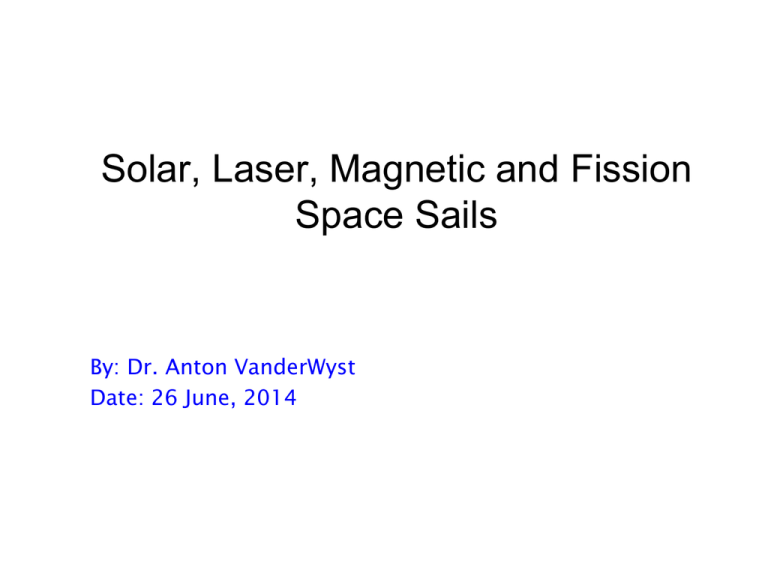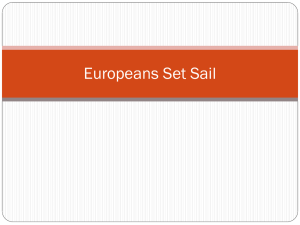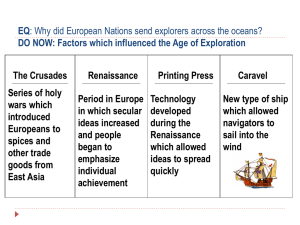Solar Sailing
advertisement

Solar, Laser, Magnetic and Fission Space Sails By: Dr. Anton VanderWyst Date: 26 June, 2014 Outline Description of light sail concept Solar powered Laser powered Plasma powered Fission powered One and two sail operation Description of magnetic sail concept Traditional magnet Magnet size and power needs Mini-magnetospheric plasma propulsion (M2P2) Particle beam propulsion Issues associated with light sails Sail material and missions Sail mass and volume Low thrust trajectories Solar and laser power needed Thermally limited acceleration Instersteller dust impacts Relativistic redshifting responses Conclusion APISG401 References Space Sails Page 2 Light sail concept Propellant mass is the dominant concern in modern space craft design. Propellantless methods of space propulsion provide breakthrough performance possibilities. They allow 92+% of the mass to be removed. The scientific and engineering challenges for this category of space travel will be presented as well as several unique proposed technological responses. APISG401 Space Sails Page 3 Solar powered sail Solar sails would propel a spacecraft by utilizing the pressure created by the stream of photons (tiny units of light energy) from the sun. Once a spacecraft is in orbit, a lightweight sail would unfurl. Changing the position of the sail would increase or decrease speed. The thrust created by the photon stream is extremely low and interplanetary journeys would take years [8]. 5 year Earth-Mars trajectory APISG401 Space Sails Page 4 Plasma and laser powered sails clip APISG401 Space Sails Page 5 Plasma and laser powered sails II Avoid problem of miniscule solar pressure by providing your own power source. Require massive orbiting power stations. Numerous ideas exist and have been experimentally tested. They include a magbeam [4] and focused plasma beams [6]. Ideas all exist at TRL 0-3. Have pointing accuracy and thermal issues. APISG401 Space Sails Page 6 Fission powered sail The fission sail is a type of spacecraft propulsion proposed by Robert Forward that uses fission fragments to propel a large solar sail-like craft. a plastic layer b radionuclides layer f neutralizer electron beam Defaults uses standard radioacitve decay & catches products A 10 kg instrument payload could be sent to 250 AU in 10 years using 30 mg of antihydrogen. Preliminary calculations predict 17 g of antihydrogen could send a similar probe to the next star in 40 years. Isp = 1.4 million seconds Except … global antimatter production in all history: < 1g Current antimatter cost: $300 million / g APISG401 Space Sails Page 7 One and two stage sails Sail design dictated by what you want to do once you get to the destination. The easiest is a flyby, with a one stage sail shooting back at maximum speed. Would traverse the entire solar system in <1 day, with ~3 minutes per planet useful viewing time. To analyze a target, need to stop upon arrival. Laser light from Earth (or a transmitter in Earth orbit) would be beamed at the sail. The first (white) stage would focus and redirect this light onto the second (yellow) stage. APISG401 Space Sails Page 8 Light sail analysis APISG401 Space Sails Page 9 Sail mass and area To operate with minimal mass, the system spin- or three-axis- stabilized. Acceleration driven by areal density (sail loading). Great values are <1 g/m2. That gets you to the end of the solar system in ~20 years. 9.12 AOB m 2 cos 2 hc FSS N E photon[ J ] h [ Hz ] m 2 2 c R AU s Energy and force miniscule, where h = Planck’s constant = 6.63e-34 J-s. Teaser: momentum of a photon is where the school of quantum mechanics first begins to emerge as a consequence of Debroglie's hypothesis. Total energy is a function of wavelength. Effective areas are >> 10 km2. At 1/10th water density and 10 nm thick super-sail, could pack into 1 m3. … and impossible to unfurl due to static electricity. Would shred if you lightly blew on it. The lightest current 10 x 10 m sail placed 1 AU from the sun gives 3x10-12 N force, and accelerates at 1 picometer / s2. It would travel 1 meter in 13 days. APISG401 Space Sails Page 10 Other uses for light sails 1) An antenna for communications, to help focus radio transmissions from earth 2) A dust detector – spacecraft are hit by dust continually when in space, and the number of dust impacts increase with NASA ST5 antenna size and speed. Solar sails can measure the impacts via total energy Fresnel lens measurements. 3) Etching out parts of the solar sail surface, and using that as antenna to pick up radio waves. We'd use this as a phased array radio receiver. 4) Make a Fresnel lens using an interference effect. 5) NEO diversion [14] Sample phased arrays APISG401 Space Sails Page 11 Sail material and missions Proposed sail materials are mylar, aluminum, aluminized plastics or nanotubes. Common thicknesses are 0.01 – 10 microns. Note a grain of salt is 60 microns wide. The boom uses temperature, UV or other techniques to control rigidity. Most designs use air to inflate it, but maintain geometry in other ways. There are supporting guy wires that help keep it rigid. There is a problem with tacking and changing directions. Useful ranges for usage are 0.5-3 AU. NASA’s New Millennium Missions address needed technologies. Science Technology 7-9 projects directed at specific capabilities, such as booms, unfolding and tacking. APISG401 Solar Sail Missions: Launched Cosmos I sail in June 2005 aboard Russian Volna [5]. Sail size: 600 m2 Launched NanoSail-D sail 2 Aug., 2008 aboard SpaceX Falcon 1. Sail size: 5 m2 JAXA IKAROS, launched 2010, spotted at 2 AU in May 2014 Sunjammer, Falcon9 launch in 2015. Sail size: (124 ft) 1,200 m2 Heliostorm. Tentative launch in 2018. Sail size: 22,500 m2 Solar Polar Imager (SPI). Tentative launch in 2027. Sail size: 22,500 m2 Interstellar Probe. Sail size: >100,000 m2 Space Sails Page 12 Sail trajectories Modeling low, continuous thrust trajectories is very difficult. The effect of acceleration is mm/s2, so you cannot see it Unlike a rocket, very small external perturbations need to be accurately accounted for. This includes the solar wind variation, 2 planet gravitational forces and interstellar particle Brownian motion. Very large sails have differential gravitational pulls across surface Need redundancy for cable breaks & possible cell damage Can leverage existing electric propulsion trajectory codes like SEPTOP [10]. APISG401 Pioneer 4 rocket trajectory Earth-Mars EP trajectory Space Sails Page 13 Power needed Laser sails can provide greater power density. Solar provides roughly 1.6 kW/m2 and decreases 1/r2. Lasers can provide TW/m2, which will vaporize the sail. Minimum focusing transmitter size is when diffraction limited on receiver Dr=2.44√L/Dt where Dr is the receiver diameter, 2.44 is the first diffraction minimum (“Airy Disk”), is the laser power wavelength, L is the distance and Dt is the transmitter diameter. A 1 micron IR beam fired from a 1,000 km-wide Earth lens spreads out to 1,000 km receiver by 43 LY away. At 4.3 LY, it is a 316 km wide sail. APISG401 Rayleigh criterion dictates how the effects of diffraction limit the size of a spot you can focus onto an object. As you move further away from a highly collimated laser, diffraction theory says that the spot size must increase. However, smaller wavelength = smaller spots Space Sails Page 14 Power needed, II Common needed space power ranges are 0.01-100 TW (1010 – 1014 W). • Total Earth average power is 15 GW (1010 W) National Ignition Facility (NIF) at Law. Livermore building world’s most powerful laser, at 1.2 PW (1015 W) Plaser M sail M pay asailc spot 2nreflec absorb Would require 2-6 order of magnitude increase in power/weight ratio. The Space Shuttle engines provide 164 kW/kg. That leads to a 61,000-ton space laser. A full system mass to travel 40 LY is 210 billion tons (p. 104) The ISS is currently 287 tons after 9 years and 26 dedicated Shuttle flights. Airborne Laser (ABL) is MW-class. amax APISG401 2n 4 4 T T reflec absorb SB front back max space absorb sailc Space Sails Page 15 Flight issues Maximum acceleration limited by radiation cooling limit. If any more power was applied, the sail would melt. A fast moving sail therefore must: • Be extremely light (low density ) • Have high backside emissivity • Possess high maximum temperature During the years of flight operation, (note Tmax << Tmelt due to thin film there are a large variety of possible agglomeration) failure modes. They include: • Have very high reflectivity reflec Deployment and tacking [13] • Absorb minimal thermal energy Thermal warping [11] Wobble control [12] Could also power by microwaves Short circuits closer, but cannot focus at a Solar radiation (solar wind) distance. Erosion APISG401 Space Sails Page 16 Interstellar debris impacts A light sail will impact space debris. While Dyson spheres and Bussard interstellar fusion ramjets need such interactions, sails don’t appreciate impacts at 0.5c (335 million mph). Interstellar hydrogen densities are roughly 1 atom / cm3 with 10-12 dust particles / cm3. At full speed with a 10 km x 10 km sail, that is a travel volume of 1023 cm3/ s = 1011 impacts / second. However, it isn’t all that bad, and you won’t lose thrust [15]. Key factors are: Relative impact time. The dust takes 10-16 sec to travel through the sheet. No heat can be transferred. No tearing occurs – it punches Relative size of sail. Think how much % dough a cookie cutter removes Dust impact severity highly depends on travel through the local interstellar cloud. Space Sails APISG401 Page 17 Relativistic redshift impacts The much greater problem is the substantial growth in power needed as the sail velocity increases. The redshift effect kills us at 0.5c due to Change in laser output wavelength to 3x the starting frequency 2nd stage rendezvous stage size increase of 200% Laser power increase of 73% Sail diameter increase of 31% Sail mass increase of 15% r M Mr V 1 c V 1 c 1 V2 1 2 c Can get greater force by increasing the frequency of the photon and increasing its probability of reflection. If it were possible to develop an ultra light weight material that reflects x-rays, it would be possible to focus a smaller spot on the solar sail from earth based lasers. APISG401 Space Sails Page 18 Light sail review Light sails, whether powered by natural solar or manmade lasers, have a specific niche they occupy in space propulsion. Their benefits include: • No onboard propulsion needed means a very wide variety of possible space missions become feasible. • Scalable. • Sail itself is reasonable cost. • Already launched four, so base technology is very well understood and possesses a high TRL. Difficulties: • Power needs for even small missions rapidly become exorbitant. • Cannot currently make a structure that is light enough. System performance dictated by sail density. • Releasing, unfolding and steering are difficult. • Supporting infrastructure needs exponentially grow. APISG401 Space Sails Page 19 Magnetic sail analysis APISG401 Space Sails Page 20 Standard magnetic sail The magnetic sail is a use of Lenz’s Law (flux will attempt to remain constant in a electrified wire loop). The loop should be made from superconducting wires, and will expand to a circle when powered. The craft will be attached to this loop. Charged particles meeting the loop or magsail at other angles than parallel to the magnetic field will transfer some of their momentum to the field and thus push the craft. A magsail weighing 36 tons could receive accelerations of 0.1 mm/s2 to 9 mm/s2; varying with the sail orientation. The magnetic loop is very small compared to a standard light sail, being only about 10 km in diameter. APISG401 Space Sails Page 21 Supersized magnetic sail World record magnetic field is >37 T [16] Earth’s field is 30-60 T (0.3-0.6 Gauss) World record current density is > 7e8 [A/m2] World record current is 20 kA at CERN National High Field Magnetic Laboratory has 21 T, 5 m tall, 13 ton, 40 MJ magnet. Problem is that to create a large field requires ‒ Very large and heavy magnets ‒ Energy replacement due to charge loss Result is cannot get a large enough mag. field cheaply enough [17] Thrust thrust 10 AU thrust 100 AU Mass [N] [N] [N] [MT] APISG401 radius Start energy Energy loss/day Battery mass/day [km] [MJ] [MJ] [kg] 3 0.1 0.00 0.1 6 6,194 149 74 9 0.4 0.00 0.5 10 9,252 222 111 27 1.2 0.01 1.4 18 13,344 320 160 Space Sails Page 22 Mini magnetospheric plasma propulsion To reduce the cost of increasing the magnetic field radius, Mini magnetospheric plasma propulsion (M2P2) has been introduced. M2P2 still uses magnetic fields to create a large barrier to incoming particles and plasmas. The reflection of those energy fields allow very low propellant propulsion. However, it injects low-energy plasma to artifically generate a mini-magnetosphere [2]. This locally stronger magnetic field results in Isp ~35,000 seconds [1]. clip clip APISG401 Space Sails Page 23 Particle beam behavior Space particle beams can be used in magsails [18]. Benefits include: ISPs [15,000 – 45,000] range Suited for interstellar precursor miss. Problems include: Requires a dedicated beamed momentum source Particles hit a pusher plate or reflect of EM wall Beam can be deflected by solar magnetic fields. Relativistic velocities make closed-loop control impossible. Neutral particles are unaffected by EM fields APISG401 Particle beam generator MagSail operation Space Sails Page 24 Conclusions Several different ‘no to minimal’ propellant methods of imparting momentum to space vehicles have been presented. Solar, laser, fission, magnetic and particle beams have been examined. The state of the art, future programs, benefits and challenges have been identified. Each of these approaches has already been ground tested and shows appreciable promise for Moon to the edge of solar system missions. All require substantial additional scientific and engineering development before they become common methods of intersolar propulsion. The minimal propellant needed enables a large variety of missions, spanning the thrust and time ranges. APISG401 Space Sails Page 25 References [1] Winglee et al., “Simulation of mini-magnetospheric plasma propulsion (M2P2) interacting with an external plasma wind”. AIAA Joint Propulsion Conference, 2003. [2] Mini-Magnetospheric Plasma Propulsion (M2P2) Space propulsion group at the University of Washington. http://www.ess.washington.edu/Space/M2P2 /technical.html [3] Winglee et al., “M2P2: tapping the energy of the solar wind for spacecraft propulsion”. J. Geophysical research, 150(A9) p. 21067, Sept. 2000. [4] Winglee, R. and Ziemba, T. “MagBeam phase I final report for NASA institute for advanced concepts”. 30 April 2005. [5] Cosmos I, launched by the Planetary Society in 2005. http://www.planetary.org/programs/projects/solar_sailing/ [6] http://www.nas.nasa.gov/About/Education/SpaceSettlement/SolarSails/links.html [7] http://www.space.com/common/media/video/player.php?videoRef= LS_090519_SpaceEngines [8] McInnes, C. R. Solar Sailing: Technology, Dynamics and Mission Applications. SpringerVerlag, 1999. [9] http://sail.quarkweb.com/light.htm [10] Woodcock, G. R. and Dankanich, J. “Application of solar-electric propulsion to robotic and human missions in near-Earth space”. AIAA 2006-4464, JPC 10 July 2006. [11] Endicter, J. et. al. “GOES-I/M yaw momentum anomaly analysis and recovery”, SpaceOps AIAA 2008-3422. 2008. APISG401 Space Sails Page 26 References, II [12] Bajora, A. and Arora, N., and Globus, A. “Kalpana one: a new space colony design”. Space Knowledge, On Orbital Space Settlement #06. 1 Nov. 2007. [13] Herbeck, L. et. al. “Development and test of deployable ultra-lightweight CFRP-booms for a solar sail”, European Conf. on Spacecraft Structures, ESA SP-468 Mar. 2001. [14] Dachwald, B. and Wie, B. “Solar sail trajectory optimization for intercepting, impacting and deflecting near-Earth asteroids”, AIAA 2005-6176, San Francisco, CA 2005. [15] Frisbee, R. H., “Beamed-momentum lightsails for interstellar missions: mission applications and technology requirements”, AIAA 2004-3567, 11 July 2004. [16] Asano, T. et. al. “resistive insert magnet for a 37.3-T hybrid magnet”, Physics B: Condensed Matter, 294, pp 635-638, Jan. 2001. [17] http://www.sjgames.com/gurps/Roleplayer/Roleplayer29/MagSails.html [18] Bishop, F. “Some novel space propulsion systems”, J. Aircraft Engineering and Aerospace Technology, 75:3, pp. 247-255. 2003. APISG401 Space Sails Page 27





